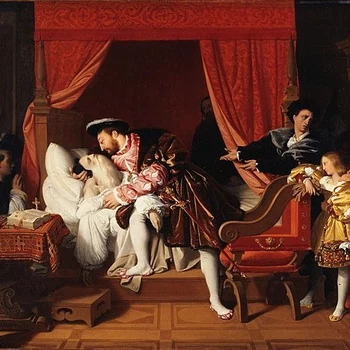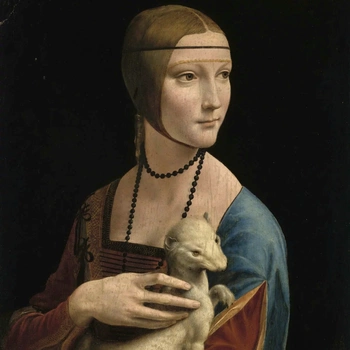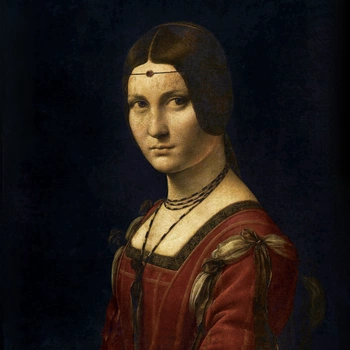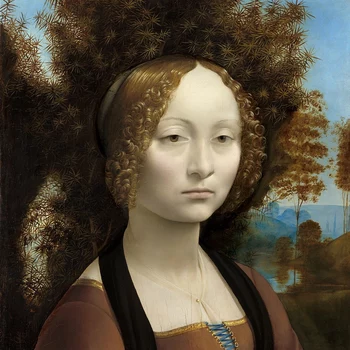Leonardo's family
Who were Leonardo's parents?
Leonardo da Vinci was the illegitimate son of Ser Piero da Vinci and Caterina. The two had a brief affair and separated shortly after his birth. After the separation, Leonardo remained with his father, who lived with his parents on an estate in Vinci.
How many brothers and sisters did Leonardo have?
Leonardo da Vinci had 17 half-siblings. Five through his mother. And twelve more through his father.
Was Leonardo da Vinci married?
Leonardo da Vinci was never married. There are no known love affairs with women. It is often claimed that Leonardo was homosexual. However, there is no concrete evidence for this.
Did Leonardo da Vinci have children?
Leonardo da Vinci had no children.
Leonardo's mother – Caterina
Almost nothing is known about Leonardo's mother Caterina. The only certainty is that her name was Caterina and that she was married to an Accattabriga the Piero del Vaccha from Vinci. This can be seen in the tax return of Leonardo's grandfather, which he made in 1457. There it lists those living with him: "[and] Lionardo, illegitimate son of the aforementioned Ser Piero and Caterina, who is now married to Achattabriga di Piero del Vaccha from Vinci." There are two main theories about the origin of Caterina. The majority of researchers now believe that Caterina was a peasant girl from Vinci.
Theory I: The peasant girl Caterina
In the tax returns from that time it appears that there was only one Caterina in the area around Vinci. This Caterina (*1427) married in 1457 one Antonio Buti di Piero del Vaccha, called Accattabriga. The Buti family managed their own farm in Campo Zeppi, about 45min walk from Vinci.
Accattabriga also worked as a lime burner. The family owned their own land, but over time had to sell more and more of it. Accattabriga's environment was characterized by financial difficulties. It is therefore conceivable that his marriage to Caterina was arranged by the Vincis, who also offered him financial incentives. In this way, the Vincis knew they would be taken care of and avoided gossip in the rural area. That there were contacts between Accattabriga and the Vincis is documented several times. For many years Leonardo's father and brother were witnesses to Accattabriga's land sales and he was a witness to the Vinci's land purchases.
Accattabriga died in 1490 at the age of about 60. His marriage to Caterina produced four daughters and one son. These five children would therefore be Leonardo's maternal half-siblings:
- Piera (c. *1454)
- Maria (*1457)
- Lisabetta (*1459)
- Francesco (*1461)
- Sandra (*1463)
Theory II: The slave Chaterina
Another theory says that the Caterina from the tax return of 1457 was an oriental slave. Leonardo would have consequently also Arab roots. The supporters of this theory argue that the Caterina from Vinci was one year older than Leonardo's father Ser Piero. However, since Ser Piero preferred much younger women, he could not possibly have desired the then 25-year-old Caterina from Vinci.
Leonardo's father Ser Piero was well acquainted with Ser Vanni, a rich notary in Florence. In his house there was an oriental slave girl, Chaterina. Slaves were uncommon in Florence of that time, but nevertheless they existed here and there. When Ser Vanni died unexpectedly in 1451, a year before Leonardo was born, he bequeathed the slave Chaterina to his wife, Agnola. Ser Piero was appointed executor of the will and therefore often stayed at the Vanni house, may even have lived there temporarily. Therefore, some suggest that he could have impregnated this Chaterina and brought the child Leonardo to the farm in Vinci. After that he would have taken care of her freedom, and married her to Antonio Buti. What is certain is that Chaterina was no longer listed as a member of Ser Vanni's widow Agnola's household in the first tax return filed after Ser Vanni's death, but not until 8 years later.
This theory, however, is highly controversial and has few supporters. Against it speaks that there was already before 1451 thus the year when there was still a slave Chaterina in Florence, already a Caterina in the area of Vinci. The slave Chaterina and the peasant girl Caterina must therefore be two different persons.
In this context it is nevertheless interesting that Leonardo later applied for a position at the court of the Ottoman sultan, which representatives of the Arabic descent theory see as an attempt to return to his roots. But it could also have been just an attempt to realize a monumental building project. Leonardo planned to build a bridge across the Bosporus to connect Europe and the Near East by land.
Leonardo's Writing Style
Furthermore, Leonardo's unusual writing style is cited as evidence of an Arabic origin. Leonardo predominantly wrote from right to left, in a mirrored fashion. Arabic script is also written from right to left. Could Leonardo have learned this way of writing from an Arabic mother who worked as an educated slave for a Florentine notary? While this is possible, it is more likely that Leonardo developed this unique writing style because he was left-handed. If he had written from left to right with his left hand, his hand would have smudged the still-wet ink and made the just-written text illegible.
Leonardo's Bridge for the Sultan
In connection with Leonardo's assumed Arabic roots, it is noteworthy that in 1503, he offered his services as an engineer to the Ottoman Sultan in a letter. The letter is now housed in the Topkapi Museum in Istanbul. Leonardo wanted to construct the longest bridge in the world at the time. It was intended to connect Constantinople (now Istanbul), which had been captured by the Ottoman Empire in 1453, with the northern neighborhoods situated on the other side of the Golden Horn. The Golden Horn is a roughly 250-meter wide estuary in Istanbul. Representatives of the theory of Arabic descent see this letter as an attempt by Leonardo to reconnect with his roots. However, it could also have simply been an attempt to undertake a monumental construction project. There is no record of the Sultan's response, and Leonardo, according to historical sources, never visited Istanbul.
Leonardo's relationship to his mother
The few historical sources from Leonardo's childhood show that Leonardo grew up in his father's family. Nevertheless, it is considered likely that he was in contact with his mother, although there is no evidence for this. Because of the local proximity, he was probably able to visit her often and was probably connected to her throughout his life. Leonardo mentions his mother Caterina only three times in his notebooks. A first entry is Leonardo's draft for a letter, dated 1481. Leonardo was about 29 years old. The badly damaged sheet, however, reveals only two short lines: "Tell, tell, tell me yet what is going on there, and let me know if the Caterina wants to do ...Tell, tell me if things ...". From the few lines it is impossible to conclude today what was the reason for Leonardo's concern.
At the age of 41 Leonardo lives in Milan. Here he mentions his mother again: "Caterina came on 16.7.1493". In the following year a Catarina died of the change fever, as can be inferred from the entry of a church in Milan. Since this church was located in the immediate vicinity of Leonardo's residence, and because Leonardo at the same time makes a note with a detailed list of the "expenses for the funeral of Caterina", it is obvious to assume that this Caterina was his mother. According to this, he took her in for care, three years after her husband Accattabriga had died. Probably her situation had become more and more precarious after the death of her husband. She lived to be about 67 years old.
Did Leonardo's mother really die in Milan?
The example of Caterina's death is a good illustration of how ambiguous the historical sources are regarding essential statements in Leonardo's life. For the entry of the church in Milan on the death of a Caterina reads in full:
"On June 26 [1494] Catharina of Florence, 6o years old, died of exchange fever. Parish of Saints Narbone and Felice in the Milanese quarter of Porta Vercellina." (Catharina was the Milanese spelling of the Florentine Caterina.)
It can now be argued that the Catharina who died in Milan need not have been the Caterina from Vinci.
- the Catharina who died in Milan in 1494 was 60 years old, would therefore have been born in 1434
- Caterina, wife of Accattabriga, living in Vinci, would have been 67 years old in 1494. This is evident from a tax return of her husband, in which she is mentioned as being 60 years old in 1487. According to this she was born in 1427
The seven years difference could be explained on the one hand by an inaccuracy of the respective scribes, who simply rounded the years. Possibly for unknown reasons they were also given a wrong age, possibly by Leonardo himself. For when his father died, he noted that he had reached the age of 80. Why Leonardo rounded to tens in both cases would then be unclear.
On the other hand, due to the shown age difference of seven years, it is possible that Catharina from Milan, who died in 1494, and Caterina from Vinci, who was recorded for tax purposes in 1487, were two different persons. The fact that Leonardo's life often seems so mysterious today is due to these and similar inconsistencies. Nevertheless, it is widely accepted in Leonardo research today that Catharina Leonardo's mother, who died in Milan, was from Vinci/Florence.
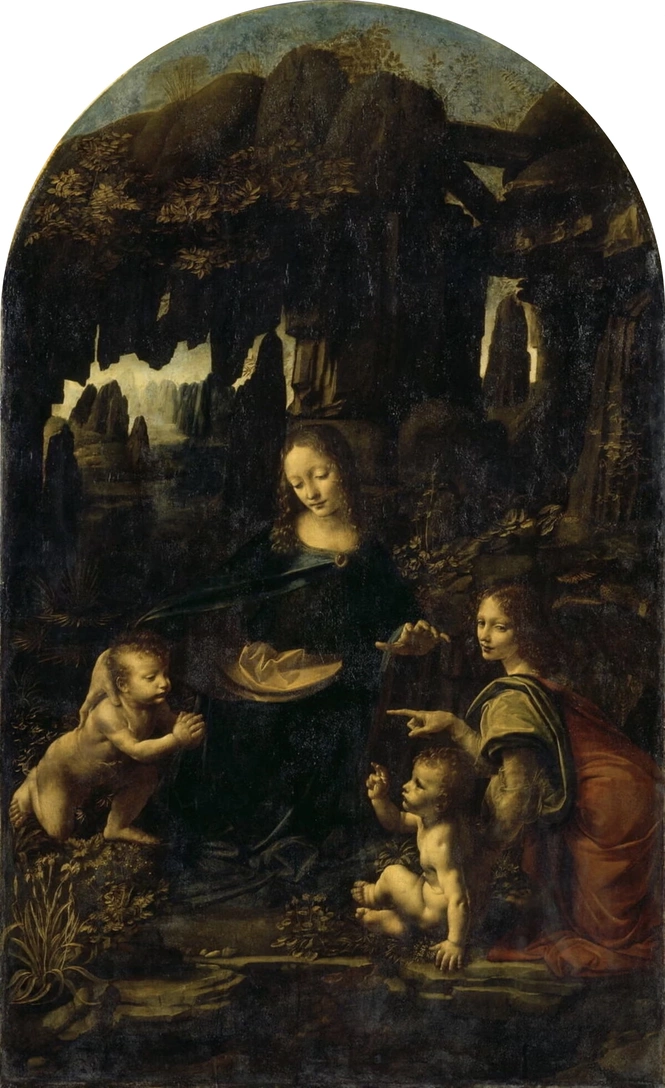
Virgin of the Rocks
1483-1486
Oil on wood, 122 × 199 cm
Paris, Musée du Louvre
Leonardo's paternal family
Notaries
The Vinci family can be traced back to 1339. Leonardo's male ancestors had been respected notaries in Florence for generations. One member of the family, Leonardo's great-grandfather Ser Piero da Vinci, had made it to the position of notary public of the Florentine city government, even becoming envoy of the Republic of Florence. Leonardo's father is named after him. The Vincis specifically married women from Florentine notary families, presumably for status considerations. The family was quite prosperous, but not exceptionally wealthy.
Landed gentry
It was fashionable at the time for the well-to-do citizens of Italian cities to buy a house in the country and spend the hot summers there. Leonardo's family also began to acquire land in and around Vinci, a village not far from Florence. Over the decades, this became quite a sizable estate. It included some houses in Vinci and farms in the surrounding area, which were leased to the people of the area. The rent was usually paid in kind, such as grain, olive oil or wine. The income from the leases ensured the Vinci family enough income to be financially independent. They also steadily expanded their holdings over the decades. Thus, it was possible for some family members not to pursue regular work and exclusively manage the family estates. This is what Leonardo's grandfather Antonio and his uncle Francesco did.
Leonardo's grandparents – Antonio and Lucia
Little is known about Leonardo's grandfather Antonio da Vinci (*1372). He was probably trained as a notary, as were all his ancestors. Probably because he was the only son of his parents, however, he did not practice and instead managed the family properties in Vinci.
He was married to Lucia (*1393), who was about 20 years younger and came from a notary family in the neighboring town of Baccheretto. They had three sons and one daughter:
- Ser Piero (*1426), Leonardo's father
- Giuliano (*1427), must have died as a child, because there are no later documents about him
- the daughter Violante (*1432)
- Francesco (*1436)
Antonio's records about Leonardo
Antonio noted important family events in a family diary, which had already been started by his grandfather Ser Guido. Thus there is also a note by the 80-year-old Antonio about Leonardo's birth and baptism.
"On April 15, Saturday, at 3 o'clock in the night [meaning three hours after sunset, so about 11:00 p.m.] my grandson, son of Ser Piero, my son, was born. He was named Lionardo, it baptized the priest Piero di Bartolomeo from Vinci, present were Papino di Nanni Banti, Meo di Tonino, Piero di Malvolto, Nanni di Venzo, Arigo di Giovanni Todesco, Monna [short for Madonna, meaning 'woman'] Lisa di Domenico di Brettone, Monna Antonia di Giuliano, Monna Niccholosa del Barna, Monna Maria, daughter of Nanni di Venzo and Monna Pippa di Previchone. "
They baptized Leonardo on the first Sunday after Easter in 1452. The fact that Leonardo was born out of wedlock seems to have been unproblematic for the community. This is because the number of people present indicates that it was not a clandestine event in the small community. Illegitimate children were not uncommon and usually came into the care of the father's family. This was also the case for Leonardo, who spent at least the first twelve years of his life in the household of his grandparents. This is evidenced by a tax return of the grandfather from 1457 in which the five-year-old Leonardo is listed as a member of the household. The country life and the relatively simple lifestyle certainly had a great influence on Leonardo's personal development.
Death of the grandparents
When exactly the grandparents died is unknown. The grandfather certainly died before 1465, since he is mentioned in that year by his son Ser Piero with the addition 'deceased'. The grandmother Lucia outlived her husband and lived to be at least 76 years old, as she is listed as a member of Ser Piero's household in a 1469 tax return. According to this, she had left the village of Vinci and was living with her son in Florence. Her exact year of death is unknown.
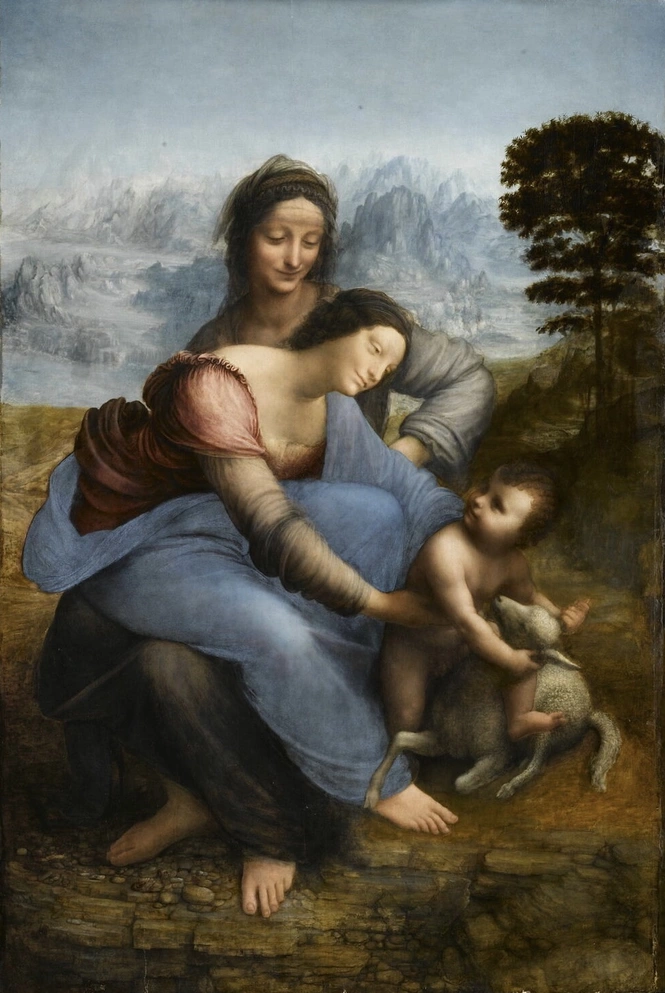
The Virgin and Child with Saint Anne
around 1502-1516
Oil on wood, 130 x 168 cm
Paris, Musée du Louvre
Leonardo's father – Ser Piero
Vinci childhood and education
Leonardo da Vinci's father, Ser Piero da Vinci was born on 19.04.1426. He grew up on the family estates in Vinci and later, like all his ancestors, was trained as a notary. Hence the 'Ser' in his name. This was a name suffix reserved exclusively for lawyers.
Ser Piero probably worked as a notary from 1446, since a tax return from that year no longer lists him in the household of his father Antonio. He first worked in Pistoia, about 35 km from Florence, where his sister Violante had married. Around 1452 he had a brief affair with a Caterina who bore him his first son, Leonardo. As was customary at the time, Ser Piero acknowledged the illegitimate child, but gave him into the care of his parents in Vinci. Since Ser Piero was very busy, career-minded, and traveled a lot, Leonardo probably did not see him much during his childhood. It is possible that Ser Piero stayed briefly in Pisa before finally settling in Florence from 1458 at the latest. This is evidenced by a contract issued by him in that year. Leonardo was about six years old at that time and lived, still separated from his father, with his grandparents in Vinci.
Ser Piero brings Leonardo to Florence
About 1464 Leonardo's grandfather Antonio died. His son Ser Piero calls him 'deceased' in a document in 1465. Probably because of this and because Leonardo was of educable age, his father brings him to Florence. Leonardo's grandmother Lucia probably accompanied him, as she too is named as a member of Ser Piero's household in a 1469 tax return. Exactly when Leonardo came to Florence is unknown. Usually an apprenticeship began at the age of 12-15, which speaks for the years between 1464 and 1467. Based on a tax return, it is safe to say that Leonardo lived with Ser Piero in Florence from 1469 at the latest, when he was 17 years old.
Ser Piero promotes Leonardo's talents
In the 1460s, Ser Piero, who was now about 40 years old, had already achieved a high reputation in Florence. As a notary, he was wealthy, had numerous political connections, and was quite influential. Leonardo was by then his only descendant, which is why he gave him special encouragement.
He provided Leonardo with an apprenticeship with the important Florentine artist Andrea del Verrocchio, who, with Botticelli, Ghirlandaio, Lorenzo di Credi and Perugino, trained many later very important painters of the Renaissance. The workshop was considered one of the most important in Italy at that time. The place of training was certainly expensive, but well chosen and certainly one of the reasons for Leonardo's later fame.
In addition, his father continued to support his son's career in later years and tried to use his growing influence as a notary in the Florentine city government to arrange commissions for Leonardo. It was probably through his mediation that Leonardo received the commissions for the unfinished works "Saint Jerome" and the "Adoration of the Magi".
Ser Piero's wives
Ser Piero married very young women who came from notary families he knew.
Caterina
Ser Piero had an affair with a Caterina around 1452. She became pregnant and bore him the illegitimate child Leonardo. Marriage to Caterina was ruled out due to differences in estates. In addition, there is the possibility that the affair coincided with Ser Piero's engagement to his first wife Albiera. A dissolution of this engagement would certainly have led to legal disputes and financial claims, especially since both families involved were notary families.
Albiera
Still in 1452, shortly after Leonardo's birth, Ser Piero married Albiera di Giovanni Amadori (*1436), who was only fifteen years old. Albiera was the daughter of a rich Florentine notary and thus a wife befitting her status. Albiera died already in 1464 at the age of 28. The marriage remained childless. Leonardo was probably deeply attached to Albiera, as he maintained close contacts with her family, especially her brother, far beyond her death, as is known from some preserved letters.
Francesca
Ser Piero remarried shortly after Albiera's death in 1465. Francesca di Ser Giovanni Lanfredini (*1449) was also very young at sixteen. She was the daughter of a Florentine notary friend. The marriage remained childless, as did that with Albiera. She also died very young at about 26 years of age around 1475.
Margherita
In 1475 Ser Piero married the 18-year-old Margherita di Francesco di Jacopo di Guglielmo (*1457). With the birth of Leonardo's half-brother Antonio in 1476, Leonardo loses his status as Ser Piero's only son. Leonardo is now already 24 years old. Margherita and Ser Piero have a total of six children until she too dies around 1486 at about 28 years old.
Lucrezia
In 1486 Ser Piero marries for the last time, the 22-year-old Lucrezia Di Guglielmo Cortigiani (*1464). With her he also fathered six children. The year of her death is unknown.
Leonardo's concern for the father
In one of Leonardo's notebooks (Codex Atlanticus 178v) is the beginning for a draft of a letter he wanted to write to his father.
"Dearest father,
on the last of last month I received your letter, which gave me joy and sorrow in the smallest of ways: joy because I learned that you were well, for which I thank God. It grieved me when I learned of your misfortune".
The entry on the otherwise blank sheet is one of the few notes that Leonardo did not write in mirror writing. It is unclear when Leonardo wrote the letter and whether he completed and sent it. Thus, the note need not be directly related to his father's death.
The death of the father
With the fall of the Duke of Milan in 1499, Leonardo lost his patron. After wandering between Italian courts for several years, he returned to Florence around 1503, at the age of 51. During this period, he created artworks like the portrait of Lisa del Giocondo, famously known as the 'Mona Lisa.' Leonardo's father, Ser Piero, was acquainted with Lisa's husband, Francesco del Giocondo, so it's possible that the painting was commissioned through the influence of Leonardo's father.
A year later, on July 9, 1504, Leonardo's father, Ser Piero da Vinci, passed away in Florence. In his will, Ser Piero did not explicitly mention Leonardo, his illegitimate son. This led to a dispute among the family members over the inheritance, and Leonardo, as an illegitimate and therefore not legally recognized son, received nothing.
Leonardo's enigmatic notes
In connection with his father's death, two separate and intriguing notes made by Leonardo are worth noting:
-
"On Wednesday at 7 o'clock, Ser Piero da Vinci died, on July 9, 1504, Wednesday at seven o'clock." (Codex Atlanticus, 196v)
-
"On July 9, 1504, Wednesday, at 7 o'clock, Ser Piero da Vinci, Notary of the Palace of the Podestà, my father, died. He was 80 years old. He left behind 10 sons and two daughters." (Codex Arundel, 272r)
These notes raise several mysteries:
- Leonardo recorded the same information in two different notebooks, with slight variations, and repeated the date and time at the end of the line in the Codex Atlanticus
- He stated that his father died on July 9, 1504, which was a Tuesday, not a Wednesday
- Leonardo indicated that his father would have turned 80 years old, which contradicts current research that suggests Ser Piero was born in 1426 (see Charles Nicholl, Leonardo). Therefore, Ser Piero would have been 78 years old when he passed away. Leonardo might have rounded up to 80 years when writing the note. Likewise, Leonardo's mother, Caterina, is officially recorded as having died at 60 years old in the parish records of the Holy Narbone, even though she was actually 67 years old. Leonardo might have provided incorrect dates to the scribes, and the reasons for this are unknown
- When listing the sons, Leonardo did not include himself. Ser Piero had a total of 11 sons, including Leonardo, not 10, and two daughters
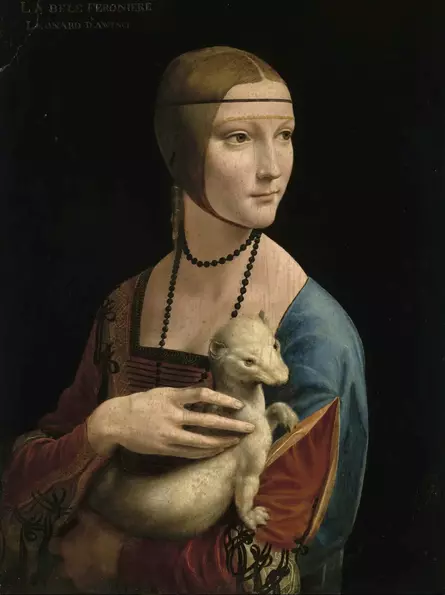
around 1490
Oil on wood, 39 x 53 cm
Krakow, Czartoryski Muzeum
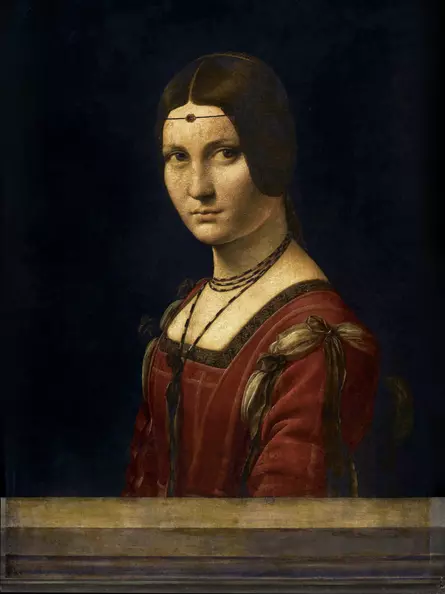
Oil on wood, 45 x 63 cm
Paris, Musée du Louvre
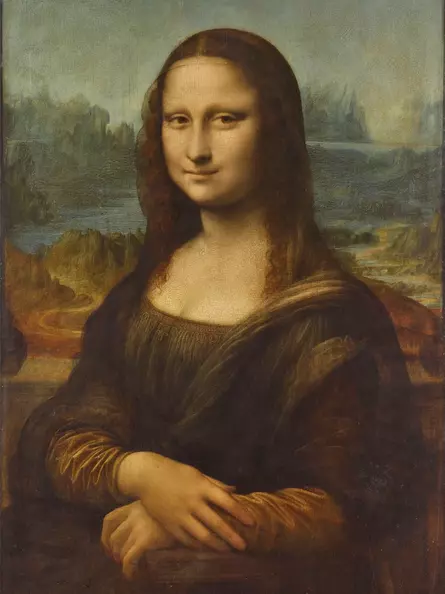
1503-1506
Öl auf Holz, 53 x 77 cm
Paris, Louvre Museum
Leonardo's uncle – Francesco
Francesco, Leonardo's uncle was born in 1436 and lived in Vinci like his parents, that is, like Leonardo's grandparents all his life and "did nothing" as it says in the tax records, so he had no profession and lived on the proceeds of the lease. With the death of his parents in the 1460s, the land ownership passed to him. In 1465 he married Alessandra Amadori (*1443), a sister of Ser Piero's first wife Albiera.
He had a very intimate relationship with Leonardo, which was probably due to the fact that he was only 17 years older and both were very close to nature. The intimate relationship can also be seen in the fact that he appointed Leonardo as his main heir when he died childless in 1507. As before with the death of his father, this inheritance was also contested by Leonardo's siblings, but this time Leonardo used his political connections and was thus able to assert his claims.
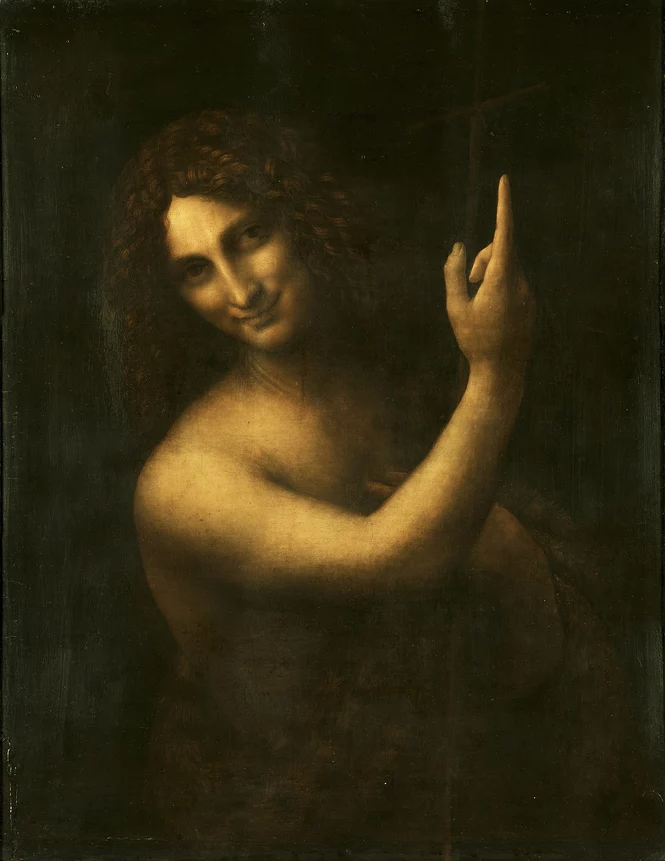
Saint John the Baptist
around 1513-1516
Oil on wood, 57 x 69 cm
Paris, Musée du Louvre
Leonardo's aunt – Violante
Almost nothing is known about Leonardo's aunt Violante. She was born in Vinci in 1432. She was the six years younger sister of Leonardo's father Ser Piero and four years older than her brother Francesco. When she was an adult, she married into Pistoia, about 30 kilometers northwest of Florence.
That Leonardo stayed several times in Pistoia is considered probable today. On the one hand, he was well acquainted with the later very famous poet Antonio Cammeli, who came from Pistoia. On the other hand, the workshop of Leonardo's teacher Verrocchio had several larger commissions in and around Pistoia around 1478.
Due to the local proximity, it is conceivable that Leonardo could have visited his aunt there. However, there are no sources that show that Leonardo was in contact with his aunt.
Leonardo's siblings
Leonardo had a total of 17 half-siblings through his father and mother. Twelve through the father and five more through the mother.
The maternal siblings are known from a tax return of 1487. There, the household members of Antonio Buti, the husband of Leonardo's presumed mother Caterina, are listed. Next to the name, the age is given, so that the year of birth can be approximately determined. In the case of Sandra and Francesco, information was added by the scribe. It is striking that in 1487 all of Caterina's daughters, although already between 24 and 33 years old, were unmarried and apparently still living at home.
From Caterina's husband Antonio Buti
- Piera (c. *1454)
- Maria (*1457)
- Lisabetta (*1459)
- Francesco (*1461), was killed by a wall breaker in Pisa [meaning a large catapult, he was probably a soldier and probably died during the siege of Pisa by the Republic of Florence]
- Sandra (b. 1463), she says she has no animals, neither her own nor those of others
Nothing is known about Leonardo's relationship with his maternal siblings.
The siblings on his father's side were
From Ser Piero's third wife Margherita
- Antonio *1476
- Magdalena *1477
- Giuliano *1479, spokesman in the dispute with Leonardo over the inheritance of uncle Franceso
- Lorenzo *1484
- Violante *1485
- Domenico *1486, spokesman in the dispute with Leonardo over the inheritance of his father Ser Piero, to him a letter of Leonardo is preserved, in which he sarcastically congratulates him on the birth of his heir.
From Ser Piero's fourth wife Lucrezia
- Margherita * 1491
- Benedetto *1492
- Pandolfo *1494
- Guglielmo *1496
- Bartolomeo *1497, father of the sculptor Pierino da Vinci (*1530-1553)
- Giovanni *1498
The respective dates of death are not known. The paternal siblings often appear in the surviving documents in connection with inheritance issues, so that it is not possible to speak of an intimate sibling relationship. Complicating matters further is the large age difference. Leonardo was Ser Piero's oldest child. The second oldest, Antonio, was 24 years younger than Leonardo.
Dispute I: Ser Piero's inheritance
When their common father died in 1504, there was a dispute about which share Leonardo was entitled to. The spokesman for the siblings was his half-brother Dominico. Since Leonardo was born out of wedlock, the siblings are able to assert themselves and exclude Leonardo from the inheritance in accordance with the law of the time. Leonardo must have been very bitter about this, so he wrote Domenico a sarcastic letter on the occasion of the birth of his son.
My dearest brother, only this to inform you that I received your lines these days, from which I learned that you have received an heir, which, as I hear, gives you the highest joy. Since I consider you wise, as on the other hand it is clear to me that even cleverness is something quite foreign to me, as it is close to you: nevertheless, you were pleased to have created for yourself an enemy who is always awake and who will do everything to get his freedom, which he will not have without your death.
Dispute II: Francesco's Inheritance – The Estates in Vinci
When Leonardo's uncle Francesco dies in 1507, the siblings, led by his half-brother Giuliano, try to exclude him as well. But this time the case turns out to be different. Leonardo was explicitly named in the will as the main heir to Francesco's estate in Vinci, and thus he had the law on his side. Since the influential Medici family had been expelled from the city between 1494 and 1512, Leonardo lacked important political allies in Florence when the new city government tended to do right by the siblings. Leonardo then exerted his political influence.
Leonardo brings the French to his aid
The French had become very important by this time, having made several conquests in northern Italy. Among other things, they had invaded Florence in 1494 and only moved on after paying a ransom and ceding territory. On another campaign under a new king, they conquered Milan in 1499. The Duke of Milan fled and Leonardo lost his long-time patron. However, he quickly established close personal contacts with the French.
The French royal court admired Leonardo's work, and even wanted to have the just-completed Last Supper taken down in Milan and shipped to France. This admiration and courting of Leonardo led nine years later to his being commissioned in 1508, first for the French governor in Milan and later directly for the French king.
Because of these sympathies, Leonardo was able in 1507 to ask the French governor of Milan and even the French king himself to intervene personally on his behalf in Florence and avert the injustice threatening him in his favor by having the will recognized as valid. The intercessory letters from the French to the Florentine municipal government have been preserved. The Republic of Florence was dependent on the goodwill of France in view of numerous defensive battles against rival powers and wanted to avoid diplomatic upsets. The will was recognized in Leonardo's sense.
To our dear, great friends, allies and allies, the Gonfaloniere and the Priors of Florence.
Louis by the Grace of God
King of France,
Duke of Milan,
Lord of Genoa.Dear great friends! We have been informed that our dear, dearly beloved Leonardo da Vinci, our painter and engineer, has a quarrel and an imminent trial in Florence against his brothers because of an inheritance which is denied him. And because he cannot easily devote himself to this trial, because of the continuous occupation he has with and around our person, we particularly wish that this trial be put to an end in the best and shortest way possible according to the law. For this reason we had to write to you by all means, and we ask you to put an end to this process and this dispute by the best and shortest procedure that the law provides. By doing so, you will be doing us a most pleasant favor.
Dearest, great friends, may our Lord protect you.
Despite the inheritance disputes, it seems that the siblings reconciled after a few years. Giuliano, the notary who was a leading figure in the dispute over their uncle Francesco's inheritance, was in Rome in 1514 for professional reasons. He had been denied a fee that he was now trying to recover. Leonardo was a member of the papal court in Rome at that time. There exists a letter from Leonardo to an advisor of the Pope in which he complains that his brother Giuliano's fee claim had not yet been processed, even though Leonardo had personally intervened on his behalf with several authorities, and it was a relatively small sum. Whether the matter was resolved in favor of Giuliano is not documented.
In his will dated April 23, 1519, just one week before his death, Leonardo specified that his brothers should receive a total of 400 ducats, which were equivalent to about 1.4 kilograms of pure gold. This amount represented the balance in his bank account in Florence.
However, an early source known as the Codex Magliabechiano records: "To his brothers, he left 400 ducats, which were his assets in the Hospital of Santa Maria Nuova. After his death, however, only 300 ducats were found there." It is often assumed that the anonymous author of the Codex Magliabechiano was the biographer Vasari, as many contents of the Codex overlap with his biography of Leonardo. The Codex Magliabechiano could, therefore, be a preparatory manuscript. Vasari had a tendency to create legends, and many of his statements relied on hearsay, so it cannot be stated with certainty whether the brothers indeed received less than what was promised in the will.
Leonardo's brothers did not inherit his entire estate. He also designated his two students, Salai and Francesco Melzi, as well as Vilani's servant, as co-heirs. They also inherited land and monetary assets. Francesco Melzi was to execute the will.
In view of the previous inheritance disputes, Leonardo's generosity towards his siblings is surprising. Therefore, the inheritance can certainly also be understood as a reminder not to engage in disputes over inheritance within a family, especially in the face of the death of a close relative, as had happened with them in the past.
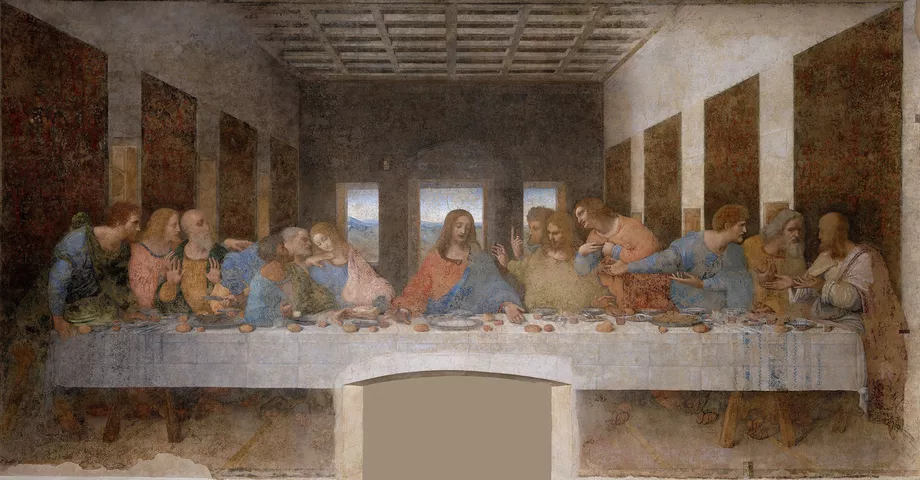
The Last Supper
around 1495-1498
Oil on tempera on plaster, 904 x 422cm
Milan, Santa Maria delle Grazie, refectory
Leonardo had 12 siblings on his father's side, 10 brothers and 2 sisters. He himself was the oldest.
Sources
Frank Zöllner, Leonardo, Taschen (2019)
Martin Kemp, Leonardo, C.H. Beck (2008)
Charles Niccholl, Leonardo da Vinci: Die Biographie, Fischer (2019)
Highly recommended
Marianne Schneider, Das große Leonardo Buch – Sein Leben und Werk in Zeugnissen, Selbstzeugnissen und Dokumenten, Schirmer/ Mosel (2019)
![[Translate to english:] [Translate to english:]](/fileadmin/_processed_/7/0/csm_anna-selbdritt_2a9498da3c.webp.pagespeed.ce.2FcjshByYA.webp)
